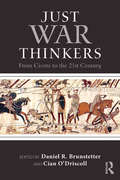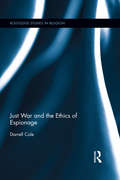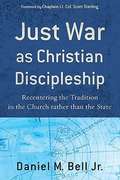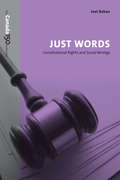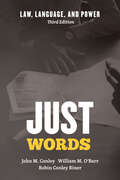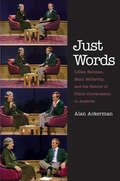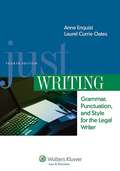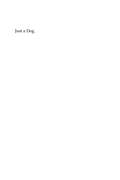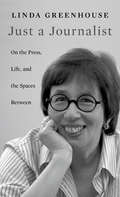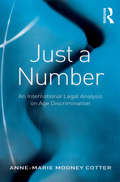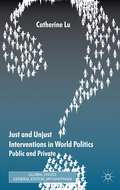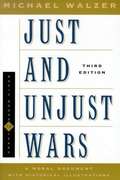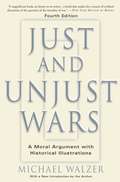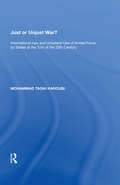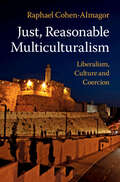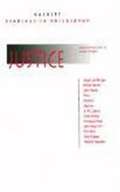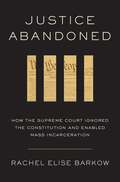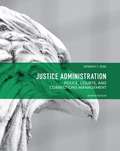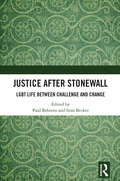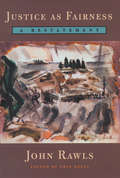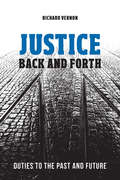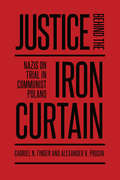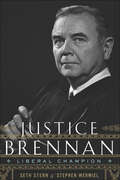- Table View
- List View
Just War Thinkers: From Cicero to the 21st Century (War, Conflict and Ethics)
by Daniel R. Brunstetter Cian O’DriscollThis volume offers a set of concise and accessible introductions to the seminal figures in the historical development of the just war tradition. In what, if any, circumstances are political communities justified in going to war? And what limits should apply to the conduct of any such war? The just war tradition is a body of thought that helps us think through these very questions. Its core ideas have been subject to fierce debate for over 2,000 years. Yet they continue to play a prominent role in how political and military leaders address the challenges posed by the use of force in international society. Until now there has been no text that offers concise and accessible introductions to the key figures associated with the tradition. Stepping into this breach, Just War Thinkers provides a set of clear but detailed essays by leading experts on nineteen seminal thinkers, from Cicero to Jeff McMahan. This volume challenges the reader to think about how traditions are constituted—who is included and excluded, and how that is determined—and how they serve to enable, constrain, and indeed channel subsequent thought, debate, and exchange. This book will be of much interest to students of just war tradition and theory, ethics and war, philosophy, security studies and IR.
Just War and International Order
by Nicholas RenggerAt the opening of the twenty-first century, while obviously the world is still struggling with violence and conflict, many commentators argue that there are many reasons for supposing that restrictions on the use of force are growing. The establishment of the International Criminal Court, the growing sophistication of international humanitarian law and the 'rebirth' of the just war tradition over the last fifty years are all taken as signs of this trend. This book argues that, on the contrary, the just war tradition, allied to a historically powerful and increasingly dominant conception of politics in general, is complicit with an expansion of the grounds of supposedly legitimate force, rather than a restriction of it. In offering a critique of this trajectory, 'Just War and International Order' also seeks to illuminate a worrying trend for international order more generally and consider what, if any, alternative there might be to it.
Just War and the Ethics of Espionage (Routledge Studies in Religion)
by Darrell ColeThe War on Terror has raised many new, thorny issues of how we can determine acceptable action in defense of our liberties. Western leaders have increasingly used spies to execute missions unsuitable to the military. These operations, which often result in the contravening of international law and previously held norms of acceptable moral behavior, raise critical ethical questions—is spying limited by moral considerations? If so, what are they and how are they determined? Cole argues that spying is an act of force that may be a justifiable means to secure order and justice among political communities. He explores how the just war moral tradition, with its roots in Christian moral theology and Western moral philosophy, history, custom and law might help us come to grips with the moral problems of spying. This book will appeal to anyone interested in applied religious ethics, moral theology and philosophy, political philosophy, international law, international relations, military intellectual history, the War on Terror, and Christian theological politics.
Just War as Christian Discipleship: Recentering the Tradition in the Church rather than the State
by Daniel M. BellThis provocative and timely primer on the just war tradition connects just war to the concrete practices and challenges of the Christian life. Daniel Bell explains that the point is not simply to know the just war tradition but to live it even in the face of the tremendous difficulties associated with war. He shows how just war practice, if it is to be understood as a faithful form of Christian discipleship, must be rooted in and shaped by the fundamental convictions and confessions of the faith. The book includes a foreword by an Army chaplain, Scott Sterling, who has served in Iraq and study questions for group use.
Just Words: Constitutional Rights and Social Wrongs
by Joel BakanThe Canadian Charter of Rights is composed of words that describe the foundations of a just society: equality, freedom, and democracy. These words of justice have inspired struggles for civil rights, self-determination, trade unionism, the right to vote, and social welfare. Why is it, then, that fifteen years after the entrenchment of the Charter, social injustice remains pervasive in Canada?Joel Bakan explains why the Charter has failed to promote social justice, and why it may even impede it. He argues that the Charter's fine-sounding words of justice are 'just words.' Freedom, equality and democracy are fundamental principles of social justice. The Canadian Charter of Rights and Freedoms entrenches them in Canada's highest law, the constitution. Yet the Charter has failed to promote social justice in Canada. In Just Words, Joel Bakan explains why. Sophisticated in its analyses but clearly written and accessible, Just Words is cutting-edge commentary by one of Canada's rising intellectuals.
Just Words: Law, Language, and Power (Chicago Series in Law and Society)
by Robin Conley Riner John M. Conley William M. O'BarrIs it “just words” when a lawyer cross-examines a rape victim in the hopes of getting her to admit an interest in her attacker? Is it “just words” when the Supreme Court hands down a decision or when business people draw up a contract? In tackling the question of how an abstract entity exerts concrete power, Just Words focuses on what has become the central issue in law and language research: what language reveals about the nature of legal power. John M. Conley, William M. O'Barr, and Robin Conley Riner show how the microdynamics of the legal process and the largest questions of justice can be fruitfully explored through the field of linguistics. Each chapter covers a language-based approach to a different area of the law, from the cross-examinations of victims and witnesses to the inequities of divorce mediation. Combining analysis of common legal events with a broad range of scholarship on language and law, Just Words seeks the reality of power in the everyday practice and application of the law. As the only study of its type, the book is the definitive treatment of the topic and will be welcomed by students and specialists alike. This third edition brings this essential text up to date with new chapters on nonverbal, or “multimodal,” communication in legal settings and law, language, and race.
Just Words: Lillian Hellman, Mary Mccarthy, and the Failure of Public Conversation in America
by Alan AckermanIn an appearance on The Dick Cavett Show in 1980, the critic Mary McCarthy glibly remarked that every word author Lillian Hellman wrote was a lie, "including 'and' and 'the.'" Hellman immediately filed a libel suit, charging that McCarthy's comment was not a legitimate conversation on public issues but an attack on her reputation. This intriguing book offers a many-faceted examination of Hellman's infamous suit and explores what it tells us about tensions between privacy and self-expression, freedom and restraint in public language, and what can and cannot be said in public in America.
Just Writing Grammar: Punctuation and Style for the Legal Writer,Fourth Edition
by Anne EnquistAdapted from the Legal Writing Handbook's highly praised Effective Writing and Correct Writing, Just Writing covers the basic principles of good legal writing, including style, grammar, punctuation, and other mechanics of writing. Its short length and focused content make it a perfect supplemental text for any legal writing course, providing tips, techniques, and helpful advice for every step of the process planning, drafting, revising, editing, and proofreading. Just Writing guides students to eloquence in concise legal prose and contrasts plain English with legalese. The text integrates writing for English-as-a-Second-Language students in its presentation. Other supportive features include a Glossary of Usage and practice exercises on the companion website to sharpen students skills.
Just a Dog: Understanding Animal Cruelty and Ourselves
by Arnold ArlukePsychiatrists define cruelty to animals as a psychological problem or personality disorder. Legally, animal cruelty is described by a list of behaviors. In Just a Dog, Arnold Arluke argues that our current constructs of animal cruelty are decontextualized—imposed without regard to the experience of the groups committing the act. Yet those who engage in animal cruelty have their own understandings of their actions and of themselves as actors. In this fascinating book, Arluke probes those understandings and reveals the surprising complexities of our relationships with animals. Just a Dog draws from interviews with more than 250 people, including humane agents who enforce cruelty laws, college students who tell stories of childhood abuse of animals, hoarders who chronically neglect the welfare of many animals, shelter workers who cope with the ethics of euthanizing animals, and public relations experts who use incidents of animal cruelty for fundraising purposes. Through these case studies, Arluke shows how the meaning of "cruelty" reflects and helps to create identities and ideologies.
Just a Journalist: On the Press, Life, and the Spaces Between (The William E. Massey Sr. lectures in American studies ; #2015)
by Linda GreenhouseA Pulitzer Prize–winning reporter who covered the Supreme Court for The New York Times, Linda Greenhouse trains an autobiographical lens on a moment of transition in U.S. journalism. Calling herself “an accidental activist,” she raises urgent questions about the role of journalists as citizens and participants in the world around them.
Just a Number: An International Legal Analysis on Age Discrimination
by Anne-Marie Mooney CotterWhilst workers' organizations and third-party analysts around the world commonly cite age as the most prevalent form of discrimination in the workplace, age discrimination has not had the same high profile as discrimination on grounds of sex or race. This book allows readers to better understand the issue of ageism and inequality. It examines the primary role of legislation and court process in combating age discrimination at both national and international levels. Including the role of NAFTA and the EU in this respect, it also provides a detailed examination of the relationship between age issues and the law, and will be an important resource for those involved in age discrimination and elder rights.
Just and Unjust Interventions in World Politics: Public And Private (Global Issues)
by Catherine LuTaking insights and controversies from feminist political theory, Lu looks to illuminate alternative images of 'sovereignty as privacy' and 'sovereignty as responsibility', and to identify new challenges arising from the increased agency of private global civil society, and their relationship with the world of states.
Just and Unjust Military Intervention
by Stefano Recchia Jennifer M. WelshClassical arguments about the legitimate use of force have profoundly shaped the norms and institutions of contemporary international society. But what specific lessons can we learn from the classical European philosophers and jurists when thinking about humanitarian intervention, preventive self-defense or international trusteeship today? The contributors to this volume take seriously the admonition of contextualist scholars not to uproot classical thinkers' arguments from their social, political and intellectual environment. Nevertheless, this collection demonstrates that contemporary students, scholars and policymakers can still learn a great deal from the questions raised by classical European thinkers, the problems they highlighted, and even the problematic character of some of the solutions they offered. The aim of this volume is to open up current assumptions about military intervention, and to explore the possibility of reconceptualizing and reappraising contemporary approaches.
Just and Unjust Wars: A Moral Argument With Historical Illustrations, 3rd Ed.
by Michael WalzerThis classic work examines the issues surrounding military theory, war crimes, and the spoils of war from the Athenian attack on Melos to the My Lai massacre. A revised and updated classic treatment of the morality of war written by one of our country's leading philosophers. Just and Unjust Wars examines a variety of conflicts in order to understand exactly why, according to Walzer, "the argument about war and justice is still a political and moral necessity." Walzer's classic work draws on historical illustrations that range all the way from the Athenian attack on Melos to this morning's headlines, and uses the testimony of participants-decision makers and victims alike-to examine the moral issues of warfare.
Just and Unjust Wars: A Moral Argument with Historical Illustrations, 4th Ed.
by Michael WalzerFrom the Athenian attack on Melos to the My Lai Massacre, from the wars in the Balkans through the first war in Iraq, Michael Walzer examines the moral issues surrounding military theory, war crimes, and the spoils of war. He studies a variety of conflicts over the course of history, as well as the testimony of those who have been most directly involved--participants, decision makers, and victims. In his introduction to this new edition, Walzer specifically addresses the moral issues surrounding the war in and occupation of Iraq, reminding us once again that "the argument about war and justice is still a political and moral necessity. "
Just or Unjust War?: International Law and Unilateral Use of Armed Force by States at the Turn of the 20th Century
by Mohammad Taghi KaroubiThis study examines the traditional theory of just war in the light of modern principles of international law relating to the prohibition on the use of force repeatedly stressed by UNGA (United Nations General Assembly) resolutions and accepted by the ICJ (International Court of Justice). The author expresses doubts as to whether actions by some permanent members of the Security Council starting from September 1996 until April 2003, in the Balkans and the Persian Gulf, are legitimate under the just war theory, or any other rules of international law, and analyses in detail the claims made by the allied powers to justify their actions. The book also examines the significance of the transformation in the limitation and prohibition of the use of force in the contemporary legal system, by studying the origin of those tenets and their reflection in both the national laws of individual states and the international laws of armed conflict.
Just, Reasonable Multiculturalism: Liberalism, Culture and Coercion
by Raphael Cohen-AlmagorThis book explores the main challenges against multiculturalism. It aims to examine whether liberalism and multiculturalism are reconcilable, and what are the limits of liberal democratic interventions in illiberal affairs of minority cultures within democracy. In the process, this book addresses three questions: whether multiculturalism is bad for democracy, whether multiculturalism is bad for women, and whether multiculturalism contributes to terrorism. Just, Reasonable Multiculturalism argues that liberalism and multiculturalism are reconcilable if a fair balance is struck between individual rights and group rights. Raphael Cohen-Almagor contends that reasonable multiculturalism can be achieved via mechanisms of deliberate democracy, compromise and, when necessary, coercion. Placing necessary checks on groups that discriminate against vulnerable third parties, the approach insists on the protection of basic human rights as well as on exit rights for individuals if and when they wish to leave their cultural groups.
Justice (Hackett Readings in Philosophy)
by Jonathan WestphalThe readings in Justice include the central philosophical statements about justice in society organized to illustrate both the political vision of a good society and different attempts at an analysis of the concept of justice.
Justice Abandoned: How the Supreme Court Ignored the Constitution and Enabled Mass Incarceration
by Rachel Elise BarkowAn influential legal scholar argues that the Supreme Court played a pivotal role in the rise of mass incarceration in America.With less than 5 percent of the world’s population and almost a quarter of its prisoners, America indisputably has a mass incarceration problem. How did it happen? Tough-on-crime politics and a racially loaded drug war are obvious and important culprits, but another factor has received remarkably little attention: the Supreme Court. The Constitution contains numerous safeguards that check the state’s power to lock people away. Yet since the 1960s the Supreme Court has repeatedly disregarded these limits, bowing instead to unfounded claims that adherence to the Constitution is incompatible with public safety.In Justice Abandoned, Rachel Barkow highlights six Supreme Court decisions that paved the way for mass incarceration. These rulings have been crucial to the meteoric rise in pretrial detention and coercive plea bargaining. They have enabled disproportionate sentencing and overcrowded prison conditions. And they have sanctioned innumerable police stops and widespread racial discrimination. If the Court were committed to protecting constitutional rights and followed its standard methods of interpretation, none of these cases would have been decided as they were, and punishment in America would look very different than it does today.More than just an autopsy of the Supreme Court’s errors, Justice Abandoned offers a roadmap for change. Barkow shows that the originalist methodology adopted by the majority of the current Court demands overturning the unconstitutional policies underlying mass incarceration. If the justices genuinely believe in upholding the Constitution in all cases, then they have little choice but to reverse the wrongly decided precedents that have failed so many Americans.
Justice Administration: Police Courts and Corrections Management (Seventh Edition)
by Kenneth J. PeakThis seventh edition of Justice Administration: Police, Courts, and Corrections Management continues its examination of all facets of the criminal justice system as well as several related matters of interest to prospective and current administrators. The general goal of the book is to inform the reader of the primary people, practices, and terms that are utilized in justice administration. The author has held several administrative and academic positions in a criminal justice career spanning more than 35 years; thus, this book’s 16 chapters contain a palpable real-world flavor not found in most textbooks.
Justice After Stonewall: LGBT Life Between Challenge and Change
by Paul Behrens Sean BeckerJustice After Stonewall is an interdisciplinary analysis of challenges and progress experienced by the LGBT community since the Stonewall riots in 1969. The riots (sparked by a police raid in New York City) are a milestone in LGBT history. Within a short time, a new feeling of confidence emerged, manifested in new LGBT organisations and the first Pride marches. Legal and social change followed: from the decriminalisation of homosexual activities to anti-discrimination laws and the legalisation of same-sex marriage. This makes it tempting to think of modern LGBT history as an unequivocal success story. But progress was not achieved everywhere: in 70 States, same-sex relations are still criminalised; violence against LGBT persons still occurs, and transgender people still struggle to have their rights recognised. The question whether the path since Stonewall represents success or failure cannot be answered by one discipline alone. This book breaks new ground by bringing together experts from politics, sociology, law, education, language, medicine and religion to discuss fields as diverse as same-sex marriage, transgender students, the LGBT movement in Uganda and LGBT migrants in the Arabian Peninsula, conversion 'therapy', and approaches to LGBT matters in Judaism, Christianity and Islam. What emerges is a rich tapestry of LGBT life today and its consideration from numerous perspectives. Based on thorough research, this book is an ideal text for students and scholars exploring LGBT matters. At the same time, its engaging style makes it a particularly valuable resource for anyone with an interest in LGBT matters and their reception in today's world.
Justice As Fairness: A Restatement
by John Rawls Erin KellyThis book originated as lectures for a course on political philosophy that Rawls taught regularly at Harvard in the 1980s. In time the lectures became a restatement of his theory of justice as fairness, revised in light of his more recent papers and his treatise Political Liberalism (1993). As Rawls writes in the preface, the restatement presents "in one place an account of justice as fairness as I now see it, drawing on all [my previous] works. " He offers a broad overview of his main lines of thought and also explores specific issues never before addressed in any of his writings. Rawls is well aware that since the publication of A Theory of Justice in 1971, American society has moved farther away from the idea of justice as fairness. Yet his ideas retain their power and relevance to debates in a pluralistic society about the meaning and theoretical viability of liberalism. This book demonstrates that moral clarity can be achieved even when a collective commitment to justice is uncertain.
Justice Back and Forth: Duties to the Past and Future
by Richard VernonIdeas of justice have traditionally focused on what individuals owe to one another and have drawn our attention to what is considered fair - what one of us owes to another is justly matched by what the other owes to them. However, what does justice require us to do for past and future generations?In Justice Back and Forth, award-winning author Richard Vernon explores the possibility of justice in cases where time makes reciprocity impossible. This "temporal justice" is examined in ten controversial cases including the duty to return historical artifacts, the ethics and politics of parenting, the punishment of historical offences, the right to procreate, and the imposition of constitutions on future citizens. By deftly weaving together discussions on historical redress and justice for future generations, Vernon reveals that these two opposing topics can in fact be used to illuminate each other. In doing so, he concludes that reciprocity can be adapted to serve intergenerational cases.
Justice Behind the Iron Curtain: Nazis on Trial in Communist Poland (German and European Studies)
by Alexander Prusin Gabriel FinderIn Justice Behind the Iron Curtain, Gabriel N. Finder and Alexander V. Prusin examine Poland’s role in prosecuting Nazi German criminals during the first decade and a half of the postwar era. Finder and Prusin contend that the Polish trials of Nazi war criminals were a pragmatic political response to postwar Polish society and Poles’ cravings for vengeance against German Nazis. Although characterized by numerous inconsistencies, Poland’s prosecutions of Nazis exhibited a fair degree of due process and resembled similar proceedings in Western democratic counties. The authors examine reactions to the trials among Poles and Jews. Although Polish-Jewish relations were uneasy in the wake of the extremely brutal German wartime occupation of Poland, postwar Polish prosecutions of German Nazis placed emphasis on the fate of Jews during the Holocaust. Justice Behind the Iron Curtain is the first work to approach communist Poland’s judicial postwar confrontation with the legacy of the Nazi occupation.
Justice Brennan: Liberal Champion
by Seth Stern Stephen WermielA sweeping insider look at the life of William Brennan, champion of free speech and widely considered the most influential Supreme Court justice of the twentieth centuryBefore his death, William Brennan granted Stephen Wermiel access to volumes of personal and court materials that are sealed to the public until 2017. These are what Jeffrey Toobin has called “a coveted set of documents” that includes Brennan’s case histories—in which he recorded strategies behind all the major battles of the past half century, including Roe v. Wade, affirmative action, the death penalty, obscenity law, and the constitutional right to privacy—as well as more personal documents that reveal some of Brennan's curious contradictions, like his refusal to hire female clerks even as he wrote groundbreaking women’s rights decisions; his complex stance as a justice and a Catholic; and details on Brennan’s unprecedented working relationship with Chief Justice Earl Warren. Wermiel distills decades of valuable information into a seamless, riveting portrait of the man behind the Court's most liberal era.
